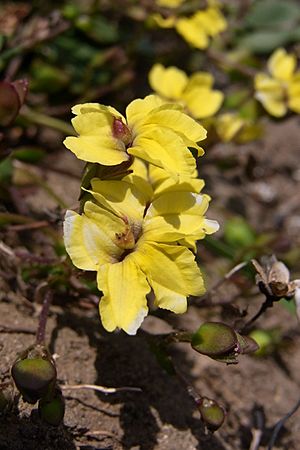Branched goodenia facts for kids
Goodenia paniculata, also known as branched goodenia, is a cool small plant found in eastern Australia. You can often spot it in wet or swampy areas, especially near the coast on sandy soil. It also grows in mountain regions like the Blue Mountains. The name paniculata refers to a type of flower cluster called a panicle. However, this plant's flowers actually grow in a different way, on structures called racemes.
Quick facts for kids Branched goodenia |
|
|---|---|
 |
|
| Cape Byron, Australia | |
| Scientific classification | |
| Genus: |
Goodenia
|
| Species: |
paniculata
|
| Synonyms | |
|
Goodenia rosulata Domin |
|
Contents
Meet the Branched Goodenia
The branched goodenia is a type of plant called a herbaceous plant. This means it has soft, green stems, not woody ones like a tree. It can grow up to 50 centimeters (about 20 inches) tall.
What Does it Look Like?
The leaves of the branched goodenia grow close to the bottom of the plant. They are shaped like an egg, wider at the top, and have jagged or "toothed" edges. These leaves can be from 1.4 to 10 centimeters (about 0.5 to 4 inches) long. They are usually 0.6 to 1 centimeter (about 0.2 to 0.4 inches) wide.
The flowers appear between October and April. They grow on a bare stalk that rises about 8 centimeters (2.5 inches) above the leaves.
Where Does it Grow?
This plant loves wet places! You can find it in freshwater wetlands or swampy areas. It grows well in clay, silty, or sandy soils. It can even grow in very acidic soil, with a pH as low as 2.5.
The branched goodenia often grows in plant communities called heaths or woodlands. It shares its home with trees like thin-leaved stringybark (Eucalyptus eugenioides), broad-leaved red ironbark (E. fibrosa), and forest red gum (E. tereticornis). Other plant neighbors include woollybutt (E. longifolia) and white feather honeymyrtle (Melaleuca decora). You might also see shrubs like prickly-leaved paperbark (M. nodosa) and tantoon (Leptospermum polygalifolium).
How it Was Discovered
The branched goodenia was first collected in Sydney, Australia, by a botanist named David Burton. This happened way back in the 1700s.
The plant was officially described for science in 1794. This description appeared in a scientific book called the Transactions of the Linnean Society of London. It was published by a famous English botanist, James Edward Smith. Later, in 1929, another botanist named Karel Domin described a plant from Queensland called Goodenia rosulata. Scientists later realized it was the same plant as Goodenia paniculata.
How it Gets Pollinated
Like many flowering plants, the branched goodenia relies on insects to help it make seeds. Insects visit the flowers, carrying pollen from one flower to another. This process is called pollination.

